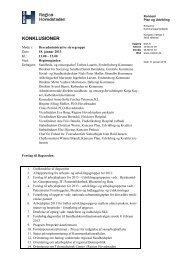Territorial Review Copenhagen - Region Hovedstaden
Territorial Review Copenhagen - Region Hovedstaden
Territorial Review Copenhagen - Region Hovedstaden
Create successful ePaper yourself
Turn your PDF publications into a flip-book with our unique Google optimized e-Paper software.
183<br />
façades, and street furniture. Such efforts have the potential to improve<br />
walkability and reinforce the attractiveness of <strong>Copenhagen</strong> (Hrushowy,<br />
2006). Nevertheless, these improvements may entail tradeoffs with public<br />
transit use. One study conducted by Næss (2005) suggests that high density<br />
communities in the <strong>Copenhagen</strong> metropolitan region, though correlated with<br />
increased walking and bike use, contribute to reduced proportions of public<br />
transit use.<br />
Though <strong>Copenhagen</strong> stands at the forefront of bicycle promotion,<br />
changes are needed to encourage additional cycling and connect this activity<br />
to the economy. The City of <strong>Copenhagen</strong> aptly addresses a number of policy<br />
goals, including the construction of additional cycle tracks, green cycle<br />
routes, bicycle parking, and safety improvements, which transcend the<br />
commitments of even the most ambitious cycle-friendly cities (City of<br />
<strong>Copenhagen</strong>, 2002, 2006). <strong>Copenhagen</strong> is particularly in need of increasing<br />
multimodality through combining cycling and public transport. Bicycles are<br />
allowed on commuter trains, although safe, covered bicycle parking needs to<br />
be expanded, especially if bicycle use is to increase. Second, <strong>Copenhagen</strong><br />
has not capitalised on its brand as one of the world‘s best cycling cities. The<br />
city has yet to conduct a value chain study on how bicycle tourism links into<br />
hotel use, restaurants, merchandise, and the employment of bicycle<br />
specialists. The impact of bicycle tourism in many areas without the cachet<br />
of <strong>Copenhagen</strong> illustrates its potential. For example, bicycle tourism in the<br />
United States‘ state of Wisconsin, generates USD 278 million per year<br />
(Bicycle Federation of Wisconsin). The Danish Cycling Foundation (Dansk<br />
Cyklist Forbund) has devoted considerable energy to writing bicycle guides<br />
in several languages that have been relatively unincorporated by<br />
<strong>Copenhagen</strong>‘s tourist office. Third, given the enthusiasm for bicycling in<br />
<strong>Copenhagen</strong>, the city could better encourage private developers to improve<br />
cycling infrastructure by illustrating how they influence property<br />
appreciation. A growing amount of research shows that homes located near<br />
or adjacent to bike trails command high selling prices (Bikes Belong, 2008).<br />
Lastly, additional efforts in regional bicycle planning need to be initiated,<br />
given the growing urban area of <strong>Copenhagen</strong> and the strict zone limits of its<br />
public bicycle program, City Bikes. Generally speaking, solutions for a<br />
regional public bicycle programme would not only benefit cyclists in<br />
<strong>Copenhagen</strong>, but cities that are plagued by similar jurisdictional issues, such<br />
as Paris‘ Vélib public bicycle rental program.<br />
Bicycling could be coupled with national obesity prevention campaigns.<br />
Though Denmark should be lauded for its ―National Action Plan Against<br />
Obesity,‖ this strategy could be improved if it explicitly included bicycle<br />
promotion. Studies have clearly shown that people who cycle to work have a<br />
28% lower mortality rate than the population average (Krag et al., 2005).

















